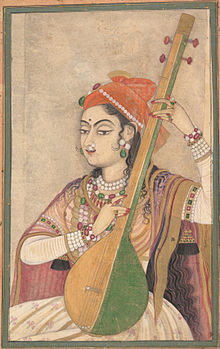Nirguni bhajans
| Music of India | |
|---|---|

A Lady Playing the Tanpura, ca. 1735 (Rajasthan)
|
|
| Genres | |
|
|
| Media and performance | |
| Music awards | |
| Music festivals | |
| Music media | |
| Nationalistic and patriotic songs | |
| National anthem | Jana Gana Mana |
| Regional music | |
|
|
A bhajan (Hindi: भजन) literally means "sharing". It also refers to any song with religious theme or spiritual ideas, in a regional Indian language.
A Bhajan has no prescribed form, or set rules, is in free form, normally lyrical and based on melodic ragas. It belongs to a genre of music and arts that developed with the Bhakti movement. It is found in the various traditions of Hinduism but particularly in Vaishnavism, in Jainism, and as Shabad Kirtan form in Sikhism.
Ideas from scriptures, legendary epics, the teachings of saints and loving devotion to a deity are the typical subjects of bhajans. It is usually a group event, with one or more lead singers, accompanied with music, and sometimes dancing. A bhajan may be sung in a temple, in a home, under a tree in open, near a river bank or a place of historic significance.
The saints of the Bhakti movement are credited with pioneering many forms of bhajans, starting with the South Indian bhakti pioneers, but bhajans have been widely composed anonymously and shared as a musical and arts tradition. Its genre such as Nirguni, Gorakhanathi, Vallabhapanthi, Ashtachhap, Madhura-bhakti and the traditional South Indian form Sampradya Bhajan each have their own repertoire and methods of singing.
The Sanskrit word bhajan or bhajana is derived from the root bhaj, which means "divide, share, partake, participate, to belong to". The word also connotes "attachment, devotion to, fondness for, homage, faith or love, worship, piety to something as a spiritual, religious principle or means of salvation".
In Hinduism, Bhajan and its Bhakti analog Kirtan, have roots in the ancient metric and musical traditions of the Vedic era, particularly the Samaveda. The Samaveda samhita is not meant to be read as a text, it is like a musical score sheet that must be heard.
Other late Vedic texts mention the two scholars Shilalin (IAST: Śilālin) and Krishashva (Kṛśaśva), credited to be pioneers in the studies of ancient drama, singing and dance. The art schools of Shilalin and Krishashva may have been associated with the performance of vedic rituals, which involved story telling with embedded ethical values. The vedic traditions integrated rituals with performance arts, such as a dramatic play, where not only praises to gods were recited or sung, but the dialogues were part of a dramatic representation and discussion of spiritual themes.
...
Wikipedia
